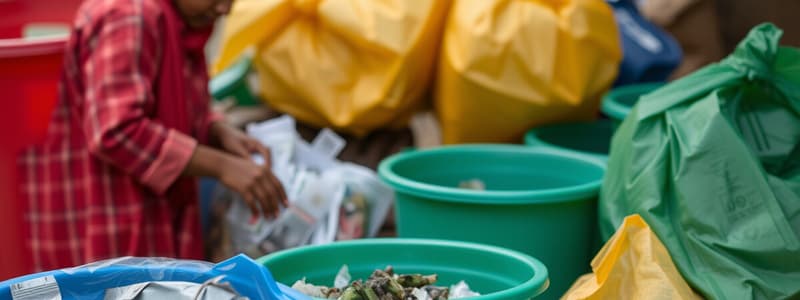Podcast
Questions and Answers
What is the definition of waste?
What is the definition of waste?
Any substance or object that the holder discards, intends to discard, or is required to discard.
What is the average weight of waste per person per year in HICs?
What is the average weight of waste per person per year in HICs?
400-800kg
What happens as countries in HICs become wealthier regarding waste?
What happens as countries in HICs become wealthier regarding waste?
People demand more consumer products, leading to a throw-away society and increased waste from old products and packaging.
What is the main type of domestic waste in HICs?
What is the main type of domestic waste in HICs?
What is the average weight of waste per person per year in LICs?
What is the average weight of waste per person per year in LICs?
What is the main type of domestic waste in LICs?
What is the main type of domestic waste in LICs?
Why is consumer purchasing limited in LICs?
Why is consumer purchasing limited in LICs?
Why is practical recycling common in LICs?
Why is practical recycling common in LICs?
In HICs, disposable items are frequently used.
In HICs, disposable items are frequently used.
In LICs, newspapers are widely sold.
In LICs, newspapers are widely sold.
Study Notes
Definition of Waste
- Waste refers to any substance or object that is discarded, intended to be discarded, or required to be discarded.
Waste in High-Income Countries (HICs)
- Average waste generation per person ranges from 400-800 kg annually.
- Notable examples include Ireland (800 kg/person/year), Norway (780 kg), and the USA (760 kg).
- Increased wealth leads to higher consumer demand, creating a "throw-away society."
- Consumers frequently replace products causing waste before items reach the end of their usefulness.
- Main domestic waste products consist of paper and cardboard, accounting for 45% of total waste, including newspapers and packaging.
- A significant contributor to waste is the packaging of purchased goods.
Waste in Low-Income Countries (LICs)
- Average waste generation per person ranges from 100-220 kg annually.
- Examples include Laos (237 kg/person/year), Vietnam (182 kg), and Thailand (73 kg).
- Main domestic waste consists primarily of food and vegetable scraps, comprising 70% of waste. Although the total amount is low, the percentage is high due to low overall waste production.
- Consumer purchasing is minimal due to low income levels, resulting in less packaging and consequently reduced plastic waste.
- Limited access to literacy translates to reduced newspaper sales; disposable products like nappies and single-use drinks containers are uncommon.
- Recycling practices are common as many cannot afford new products, with rural areas generating less waste compared to urban areas due to lower incomes.
Studying That Suits You
Use AI to generate personalized quizzes and flashcards to suit your learning preferences.
Description
Explore the differences in waste management between High-Income Countries (HICs) and Low-Income Countries (LICs) through these flashcards. Learn key definitions and statistics that highlight the disparities in waste generation based on income levels. Perfect for students studying environmental science or waste management.



